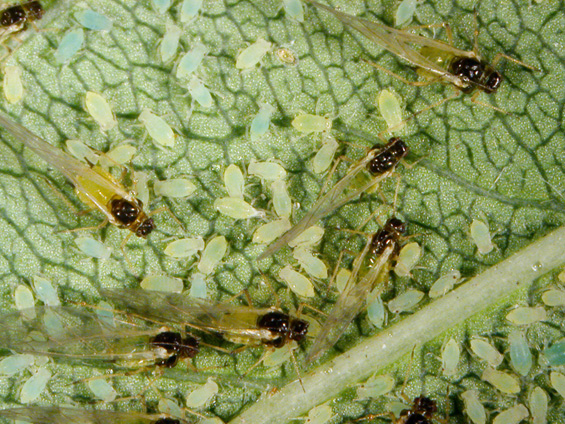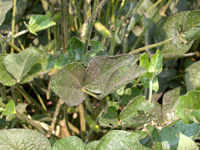
Common Name: Aphid
Scientific Name: Aphididae: several species
Status: can become very serious pests of many plants
Damaging Stage: nymph and adult
Biology: Many species of aphids are serious pests of vegetable, fruit and agronomic crops as well as ornamental plants. Aphids are small, soft-bodied insects that can be green, yellow, brown, red or black, depending upon the species. The body is usually pear-shaped with long legs and antennae. Most species have a characteristic pair of points called cornicles protruding from the posterior ends of the abdomen in an exhaust pipe-like fashion.
Aphids have many generations per year. After over�wintering, aphid eggs hatch into wingless females. These females reproduce asexually and hold the eggs in their bodies until they give birth to live young.
 Injury: Aphids can become serious pests because they have the ability to build up high populations very quickly and they feed in large colonies. Aphids may cause plant damage in three important ways. (1) Aphid nymphs and adults both feed by inserting their mouthparts into plants and sucking out plant juices. This feeding causes characteristic leaf wilting, curling and chlorosis (yellowing). This in turn may cause leaves to die and a delay in fruit and flower production. (2) As aphids feed they inject saliva into their plant host to aid in digestion of the plant cells. Some aphids transmit important plant diseases in this manner. (3) Aphids also excrete partially digested liquid material as they feed. This is called "honey dew" and serves as a base upon which sooty mold can grow. Leaves, and in extreme cases, entire plants, may become covered in this black mold which interferes with photosynthesis.
 Action Threshold: Control measures should be considered based upon the plant, its value, and when aphids are detected. Often, when 5 percent or more of the leaves become infested, management options should be considered. Aphid infestations found late in the growing season are seldom cause for treatment.
Management: Aphids are held in check by weather conditions and also by many biological predators. Lady beetles and lacewings feed almost exclusively on aphids. When used, chemical insecticides should be selected and applied such that they have minimal effects on natural control agents. Alternative controls such as Bt, and insecticidal soaps are recommended in small plantings. Insecticides that can be translocated (or moved within the plant) within the plant have shown great promise in controlling aphids.
|